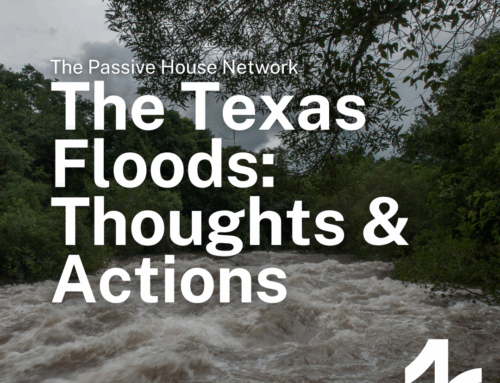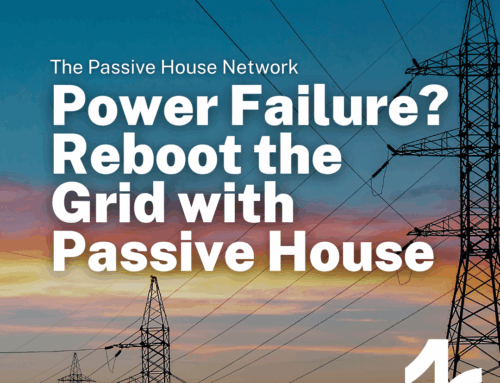The new introductory course is focused on delivering actionable information to the building trades so they can execute work on Passive House buildings.
New York, NY September 16, 2021 – The Passive House Network (PHN) announced today the launch of the Introduction to Passive House Trades course, as a half day live-online training for contractors and tradespeople working on Passive House residential and commercial building construction.
“When we look to deliver Passive House performance, the builders are full partners in making it happen – they need the Passive House tools just like the professionals,” said Sharon Gaber, PHN Managing Director. Gaber noted, “With this introductory course, builders will gain valuable insights into how and why Passive House works and provide information they can put to use on the jobsite.”
The first Introduction to Passive House Trades course will run October 13, from 1 to 5 PM ET. The cost is $195. 4 AIA LU/HSW credits are available. Topics will cover:
-
-
- Passive House basics.
- Typical construction types (commercial & residential).
- Windows and installation.
- Air barriers and insulation.
- New innovative building products.
- And more!
-
The course is accompanied by mini video tutorials for various PH product installations, plus incorporates actual building of Passive House details relevant to the US construction industry.
The course was developed in collaboration with Steven Winter Associates. Joanna Grab, SWA Senior Sustainability Consultant stated, “It is crucial for builders, when working on Passive House buildings, to properly install components, understand how to correctly implement design details and assess and plan for the current and future performance of the building. This course starts to set them up for success.”
The course, Introduction to Passive House Trades, is part of a larger Passive House education pathway, that begins with introductory classes, including a suite of on-demand introductory topics offered by the Building Energy Exchange (BEEx), based in NYC, the core Certified Passive House Designer and Certified Passive House Tradesperson courses, and other specialized expert training, all organized to build on each other and support growing high-performance competency as we work to make buildings a solution to our climate, health, and social crises.
This course can be accessed at: https://passivehousenetwork.org/education/introductory/intro-to-trades/
# # #
About The Passive House Network:
The Passive House Network (PHN), formerly known as NAPHN, is a high-performance building literacy program. We provide comprehensive, high-quality Passive House education to stakeholders across the building industry – from architects and engineers to builders and developers, to regulators and policymakers. We demystify the impact of design and construction choices, form knowledge-sharing networks, raise expectations, and transform how professionals fundamentally think and work.
PHN is an independent national non-profit educational organization affiliated with the International Passive House Association (iPHA) and the Passive House Institute (PHI), located in Darmstadt, Germany.
PHN has chapters based in New Jersey (www.njpassivehouse.com), Washington DC (www.passivehousenetwork.org), the Rocky Mountain Region (www.phrockymountains.com), Minnesota (www.passivehouseminnesota.org) and Pennsylvania (www.passivehousepa.org).
PHN supports the widespread adoption of the international Passive House design and construction standards, building science principles and protocols, as a critical response to our climate crisis – providing unparalleled effectiveness in mitigating climate disruptions and adapting to rapidly changing environmental conditions.
https://passivehousenetwork.org
About Passive House:
Passive House is an international building standard and methodology, applicable to buildings of all kinds from office buildings to hospitals, new-build and renovations, that results in a dramatic drop in operational energy use, and more comfortable and healthy occupants – meant to aggressively mitigate our climate crisis while providing resilient adaptation.
The Passive House Standard was developed by the Passive House Institute (PHI), an independent scientific research organization, located in Darmstadt, Germany, and includes specific requirements for energy use and comfort of occupants. The Passive House Standard is being successfully applied to thousands of buildings and millions of square feet around the world, from Boston to Beijing.
The Passive House methodology starts with reducing cooling, dehumidification, and heating loads by focusing, not on gadgets and active technology, but instead on fully integrated durable passive building components, such as proper continuous thermal-bridge-free insulation, continuous airtightness, high-performance windows and doors, and ventilation that includes a high-efficiency heat/energy recovery core, carefully calculated, and all integrated with the entire architectural process of design and construction. http://www.passivehouse.com http://www.passipedia.org




